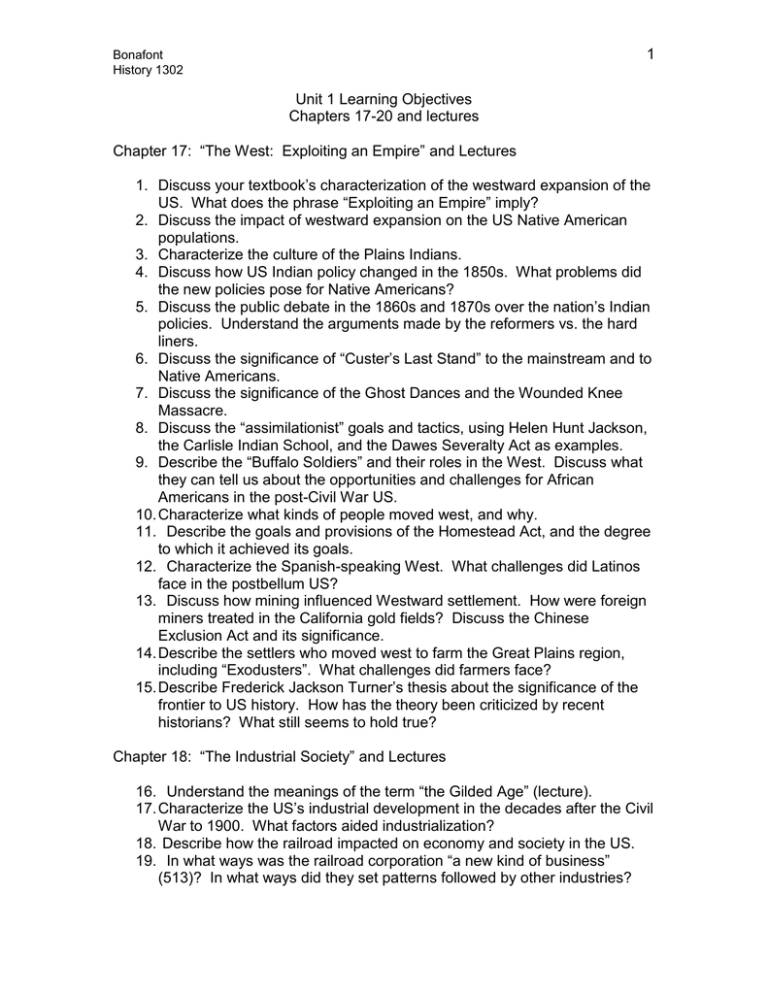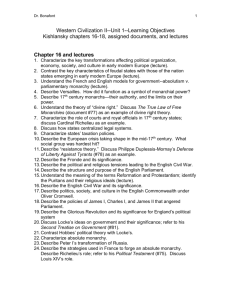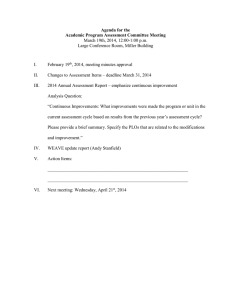1 Unit 1 Learning Objectives Chapters 17-20 and lectures
advertisement

1 Bonafont History 1302 Unit 1 Learning Objectives Chapters 17-20 and lectures Chapter 17: “The West: Exploiting an Empire” and Lectures 1. Discuss your textbook’s characterization of the westward expansion of the US. What does the phrase “Exploiting an Empire” imply? 2. Discuss the impact of westward expansion on the US Native American populations. 3. Characterize the culture of the Plains Indians. 4. Discuss how US Indian policy changed in the 1850s. What problems did the new policies pose for Native Americans? 5. Discuss the public debate in the 1860s and 1870s over the nation’s Indian policies. Understand the arguments made by the reformers vs. the hard liners. 6. Discuss the significance of “Custer’s Last Stand” to the mainstream and to Native Americans. 7. Discuss the significance of the Ghost Dances and the Wounded Knee Massacre. 8. Discuss the “assimilationist” goals and tactics, using Helen Hunt Jackson, the Carlisle Indian School, and the Dawes Severalty Act as examples. 9. Describe the “Buffalo Soldiers” and their roles in the West. Discuss what they can tell us about the opportunities and challenges for African Americans in the post-Civil War US. 10. Characterize what kinds of people moved west, and why. 11. Describe the goals and provisions of the Homestead Act, and the degree to which it achieved its goals. 12. Characterize the Spanish-speaking West. What challenges did Latinos face in the postbellum US? 13. Discuss how mining influenced Westward settlement. How were foreign miners treated in the California gold fields? Discuss the Chinese Exclusion Act and its significance. 14. Describe the settlers who moved west to farm the Great Plains region, including “Exodusters”. What challenges did farmers face? 15. Describe Frederick Jackson Turner’s thesis about the significance of the frontier to US history. How has the theory been criticized by recent historians? What still seems to hold true? Chapter 18: “The Industrial Society” and Lectures 16. Understand the meanings of the term “the Gilded Age” (lecture). 17. Characterize the US’s industrial development in the decades after the Civil War to 1900. What factors aided industrialization? 18. Describe how the railroad impacted on economy and society in the US. 19. In what ways was the railroad corporation “a new kind of business” (513)? In what ways did they set patterns followed by other industries? Bonafont History 1302 2 20. Describe the relationship between railroad corporations and the federal government. 21. Describe the business practices of large corporations. What was vertical integration? The trust? 22. Know the most important inventions developed in the late 19th century. 23. Describe how marketing became a new “science” in the late 19th century. 24. Describe the lives of the late 19th century working class. What was the pay like? The hours? The safety level? Who among the men, women, and children of the working class were wage earners? 25. Describe how skill level, sex, age, race, and ethnicity affected working class Americans. 26. How did industrialization and the rise of the corporation impact on working class Americans? How did they respond? 27. Contrast the goals, tactics, and membership of the Knights of Labor and the American Federation of Labor (AFL). 28. Describe the tactics late 19th century employers used to discourage unionization. 29. Describe the Haymarket “riot” and the Homestead Strike. What were the incidents’ significance? Chapter 19: “Toward an Urban Society, 1877-1900” and Lectures 30. Characterize the level of urbanization in the decades after the Civil War. 31. Describe living conditions a tenement. Who lived in them, and why? 32. Characterize the level of immigration into the late 19th century US. Describe the “new immigrants” and their countries of origin. 33. Describe mainstream Americans’ response to the “new immigrants.” 34. Describe how political machines and bosses functioned in late 19th century urban America. 35. Characterize “Victorian” mores and family life. 36. Describe the Plessy v. Ferguson case and decision. What was the majority opinion? The minority opinion? What is the decision’s significance? (Be sure to read pp. 567-570.) 37. Contrast the strategies of Booker T. Washington and W.E.B. DuBois. Discuss the “Atlanta Compromise” they disagreed over. 38. Discuss social Darwinism and its influence on reformers. 39. What was the significance of Henry George’s Progress and Poverty? Of Edward Bellamy’s Looking Backward? 40. Discuss the goals and values of the Social Gospel movement. 41. Describe the settlement house movement. Chapter 20: “Political Realignments in the 1890s” and Lectures 42. Describe the political culture and voting patterns of the late 19th century. Who could vote? Who couldn’t? Were election turnouts high? Bonafont History 1302 3 43. Characterize the late 19th century Republican and Democratic parties. Who were their voters? What were the parties’ stands on government regulation of the economy, society, and morals? 44. Describe the goals of the Sherman Antitrust Act, and how it was used. 45. What problems did late 19th century farmers face? How did they respond? Describe the Grange movement and the Farmers’ Alliance movement. What were their goals and tactics? 46. Describe the People’s Party (the Populists), its goals, membership, and tactics. 47. Describe the Panic of 1893 and its impact on the US economy. 48. Describe the Pullman strike, the miners’ strike, and their significance. 49. Describe the voter realignment going on in the 1894 and 1896 elections. 50. Which groups and parties backed the coinage of silver, and why? 51. What factors contributed to the success of the Republican party in the 1896 elections?

